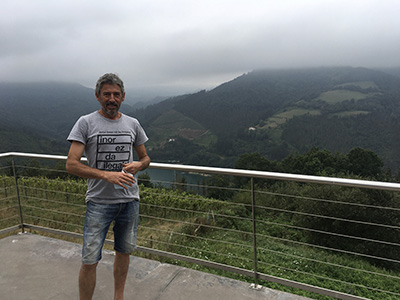Urkizahar
Urkizahar Baserria. Ilarralde Auzoa, 3, 20739, Beizama, Gipuzkoa, Spain
urkizahar.com
The expansion of the Getariako Txakolina DO to include villages across the province of Gipuzkoa in 2007 did not only provide an opportunity for restless characters eager to contribute to the development of their communities; it also widened the diversity of terroirs in contrast to the coastal vineyards that had prevailed until then. One of the most innovative projects was Urkizahar launched by Luis Javier "Luisja" Oregi and his wife Igone Arruti in Beizama, a small village tucked away in a particularly rugged area of inland Gipuzkoa.
Adjacent to the renovated caserío (Basque farmhouse), which is both a winery and a home, the two and a half hectares of vineyard slope down to the Ibai Eder reservoir (the name means "beautiful river" in Basque), which supplies water to some the traditional Txakoli towns of Getaria, Zarautz and part of Aia, among others. But before one can enjoy the breathtaking views, one must travel along a winding mountain road. Here, on a slope at an elevation ranging from 350 to 450 metres, lies what is officially the highest vineyard in the DO.
Urkizahar (old birch tree in Basque) reflects the commitment of the couple to return to the old Basque farmhouse but dignifying country life. Having an unspoiled land which had never been treated with chemicals and which had been previously destined to pastures and gardens, they decided to grow organically.
With rainfall levels similar to the coast (around 1,600mm), the Urkizahar vineyard is exposed to the warmth of the south but it also receives the influence of the sea, which means both freshness and humidity with the subsequent risk of fungal diseases. Hondarrabi Zuri, only disturbed by 500 Chardonnay plants, prevails in the vineyard. Yields are very low compared to those of the coastal areas.
2012 was the first vintage of Urkizahar. The wine was initially made in several wineries in Getaria, where Luisja had to repeatedly listen that his wine didn’t taste like txakoli, so he turned for advice to the sommelier of Arzak, the well-known, three-starred restaurant in San Sebastián, who put it on their wine list. Other leading Basque restaurants followed.
Winemaking is pretty simple. After an initial selection on the vineyard, grapes are manually harvested, then destemmed and pressed. They only use free-run juice.
Spontaneous, low-temperature fermentation in stainless steel tanks is standard since they built their cellar in their home. The couple also like to capture some carbonic to add freshness to the wine. Bottling is usually done on the summer after the harvest. Until the 2017, their best so far, they produced just one wine called Urkizahar (€14). After that year, Luija decided to age a small batch of txakoli in barrels to release a Limited Edition (€22, 1,200 bottles). Depending on the conditions of the vintage, production can range from 6,000 to just over 11,000 bottles.
Most popular
NEWSLETTER
Join our community of Spanish wine lovers


